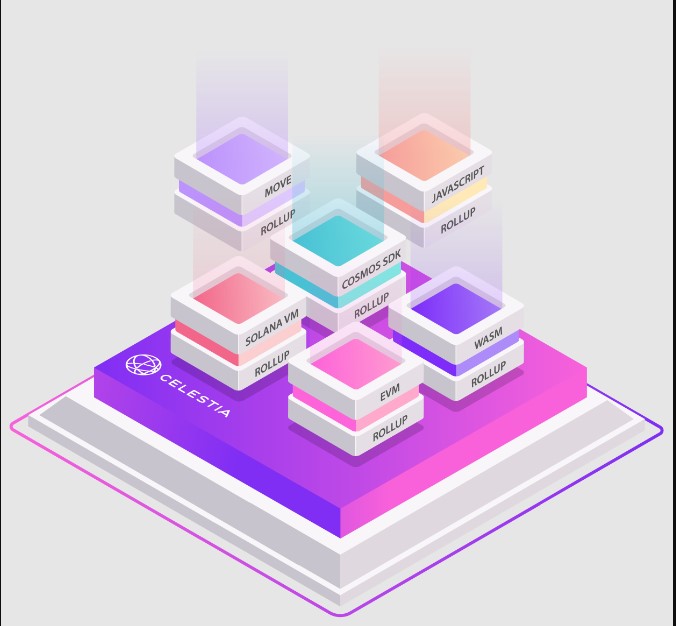Celestia (TIA) has flourished briefly following its mainnet beta launch in October 2023 and subsequent listing on Binance. Incentive opportunities undoubtedly play a role, but beyond these factors, Celestia’s modular approach that facilitates interoperability and collaboration between chains is particularly promising.
Our Celestia review will introduce the concept of modular blockchain, how Celestia approaches it, the problems Celestia is solving, and several ways you can participate in the network.
What is Celestia (TIA)?
Celestia is a modular blockchain network that exclusively offers consensus and data availability to builders to build their own blockchain on top of it.
Celestia-enabled modular architecture separates the consensus and execution layers into two distinct components. Celestia is not responsible for executing transactions, instead, it specializes in ordering transactions and ensuring data availability. That is an example of modular blockchains.
Unlike monolithic frameworks, where a blockchain has to perform execution, settlement, consensus, and data availability itself, modular approach allows for the division of labor – meaning one blockchain can perform exclusively one or a few tasks. The results of this approach are greater flexibility and scalability without sacrificing security.
What Problem is Celestia Solving?
Celestia aims to address the typical dilemma of blockchains, making them more accessible and efficient. To achieve that goal, Celestia has introduced data availability sampling (DAS).
To understand data availability sampling, let’s briefly throw back to node deployment. A blockchain infrastructure relies on nodes to store data and execute consensus. Nodes are typically split into two types: full node and light node. Full nodes keep records of all blockchain transactions while light nodes only store relevant data in order to verify transactions’ validity.
Now we have data availability sampling and it is pretty much the same. The mechanism works by having light nodes perform several rounds of random sampling on small portions of the data within each block. As they complete more rounds, the light node gains increased confidence in the data’s availability. Once the confidence in data availability reaches a predetermined level (e.g., 99%), the block data is deemed valid.
As more light nodes join Celestia, data availability sampling enables the network to scale without compromising performance or security.
DAS is a key feature of Celestia’s DA layer. Another one is Namespaced Merkle trees (NMTs), a data structure that efficiently verifies the integrity of large datasets. These two scaling solutions work together to improve the scalability and usability of rollups. You can explore in-depth insights into NMTs in this Maven11 Research.
In essence, Celestia solves the scalability limitations of traditional blockchains. Its modular approach enables blockchain technology to support growing user bases and accommodate more complex applications.
How Celestia Works and How Builders Can Benefit from Celestia
Celestia provides blockchain projects with frameworks and numerous features (resources) to launch performant, customizable blockchain rollups. Blockchain developers or teams who seek to build a new app without the overhead of managing data storage and security, will find Celestia beneficial.

Celestia’s Architecture | Source: Celestia.org
Instead of each blockchain having to handle its own data storage and security, Celestia offers a shared service that takes care of this. You can think of it as a public storage facility where each blockchain can rent a unit.
When the project produces new data, it sends this data to Celestia. Celestia securely stores the data and generates a cryptographic proof, analogous to a digital receipt, to prove it was received and stored correctly (to verify the data’s integrity and availability).
Besides developer portals and frameworks, interoperability is another major advantage of building on Celestia. Blockchains built on Celestia can seamlessly interact with one another, enabling developers to create interconnected applications capable of sharing data and functionality.
What is TIA? Use Cases of Celestia Token
TIA is Celestia’s native token. It is used to pay for publishing data to Celestia’s blockspace. The coin is also used as a gas token and currency to bootstrap new rollups, similar to how ETH is used on Ethereum-based rollups.
Users can stake TIA to participate in consensus and secure the Celestia network. Staking TIA is to delegate a number of TIA tokens to (a) Celestia validator(s) for a period and to receive staking rewards.
TIA holders can also take part in decentralized governance. This means they can vote on network parameters through governance proposals, and governing the community pool, which receives 2% of block rewards. Get more details on TIA in Celestia Docs – TIA Overview.
Celestia’s mainnet went live on October 31 this year. TIA tokens are currently listed on Binance, Bybit, and OKX, to name a few.
How to Participate in Celestia Network
Anyone can participate in Celestia Network, regardless of technical background. Below is a breakdown of ways to be part of this project:
Run a Node
If you love the idea of being an engineer, deploying and running your own node on Celestia is your cosmic playground. Light node is the simplest way to get started with node setup as it is less resource-intensive and requires minimal specs. You can also learn to set up other nodes like Validator nodes, Full consensus nodes, Bridge nodes, and Full storage nodes.
Before selecting your node, make sure you understand each node’s role and setup requirements – dive into Celestia’s Node Overview.
Develop Applications
If you’re a coding maestro with dreams of building your own digital galaxy, Celestia’s modular architecture is your coding canvas. Celestia encourages developers to build and deploy their own execution layers on top of the Celestia network while enjoying a high degree of customizability and sovereignty.
Join the Community
Still unsure if Celestia is worth your special attention? You can join the Celestia community, where blockchain enthusiasts unite.
Participate in Testnets
Celestia often runs testnets to test and improve the network. So if you’re a passionate bug hunter with a knack to spotting quirks, the door is open.
Team and Backers
Celestia has a team of accomplished blockchain engineers and system architects. Many of them held positions at prominent companies like Tendermint, ConsenSys, Ethereum Classic, and Google. Celestia CEO, Mustafa Al-Bassam, is a respected figure in the tech community, widely recognized for his valuable contributions to blockchain technology.
The project is backed by numerous high-profile VCs, including Binance Labs, Maven11, KR1, Signature Ventures, Divergence Ventures, Polychain Capital, Bain Capital, and Coinbase Ventures, among others.





 Bitcoin
Bitcoin  Ethereum
Ethereum  Tether
Tether  Solana
Solana  USDC
USDC  XRP
XRP  Lido Staked Ether
Lido Staked Ether  Dogecoin
Dogecoin  TRON
TRON